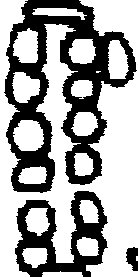I turn the picture 90o clockwise and cut out this arrangement to see it more clearly:
Notice that there are straight edges at bottom, at top and at the left gap. The arrangement of the round stones is 4 + 4 + 4 = 12. And then there is an additional bigger one at top right which perhaps means half a year. The straight edges at bottom and top probably illustrate winter solstice (thin henua) and summer solstice (thick henua), where nothing happens with the sun. It is still, not moving. Two months (like Janus doorposts) are guarding the cover stone over the solstice holes. The gap at left comes too early to be spring equinox (we are north of the equator and go clockwise), but perhaps it shows the heliacal rising of the Pleiades? If so, then what does the precessional clock tell about when? That we are about 2,000 years before the time when the Pleiades will be at spring equinox, i.e. we are at about 4,000 B.C. That agrees well with the statement: "... inundation science reveals that three islands the size of Antilia and Satanaze - islands that are today completely submerged or that have survived only in the form of tiny remnants still above sea-level - did in fact exist in the Atlantic down to as late as 6000 years ago..." (Hancock 2) The sizes of the stones also indicate that summer is at top and that spring is at left. One of my foundation stones for this building of an understanding of rongorongo is that Matariki was shown as an arrangement of 6 stones on Easter Island: "The Rapa Nui ethnographers say that 'old men' watched the stars on Poike, from a cave on the west coast or from near an ahu where six boulders represented the Pleiades…" (Van Tilburg) From this I have postulated as an axiom that these 6 stones also represented the 6 double-months of a year. The important glyph type GD53 is then - I believe - a further abstraction of this complex concept. |
